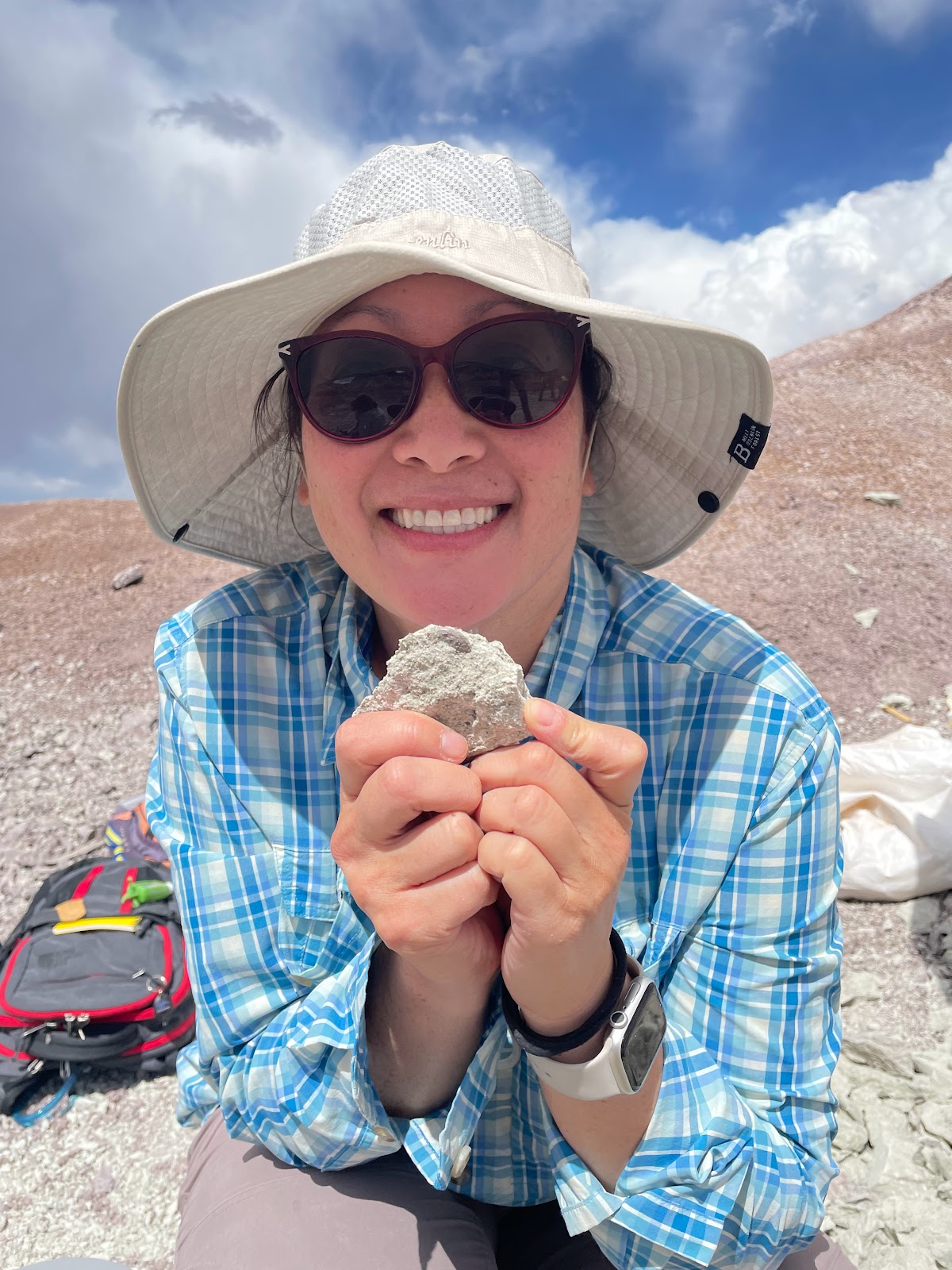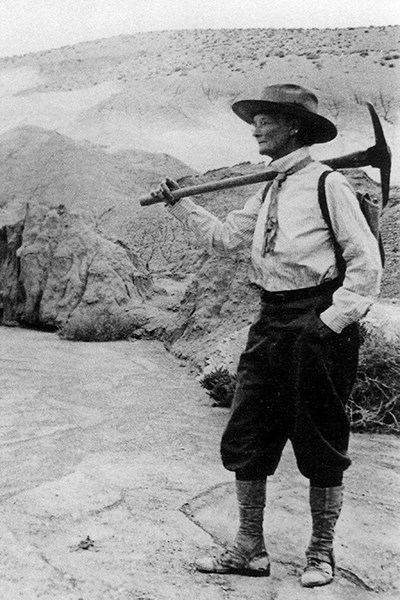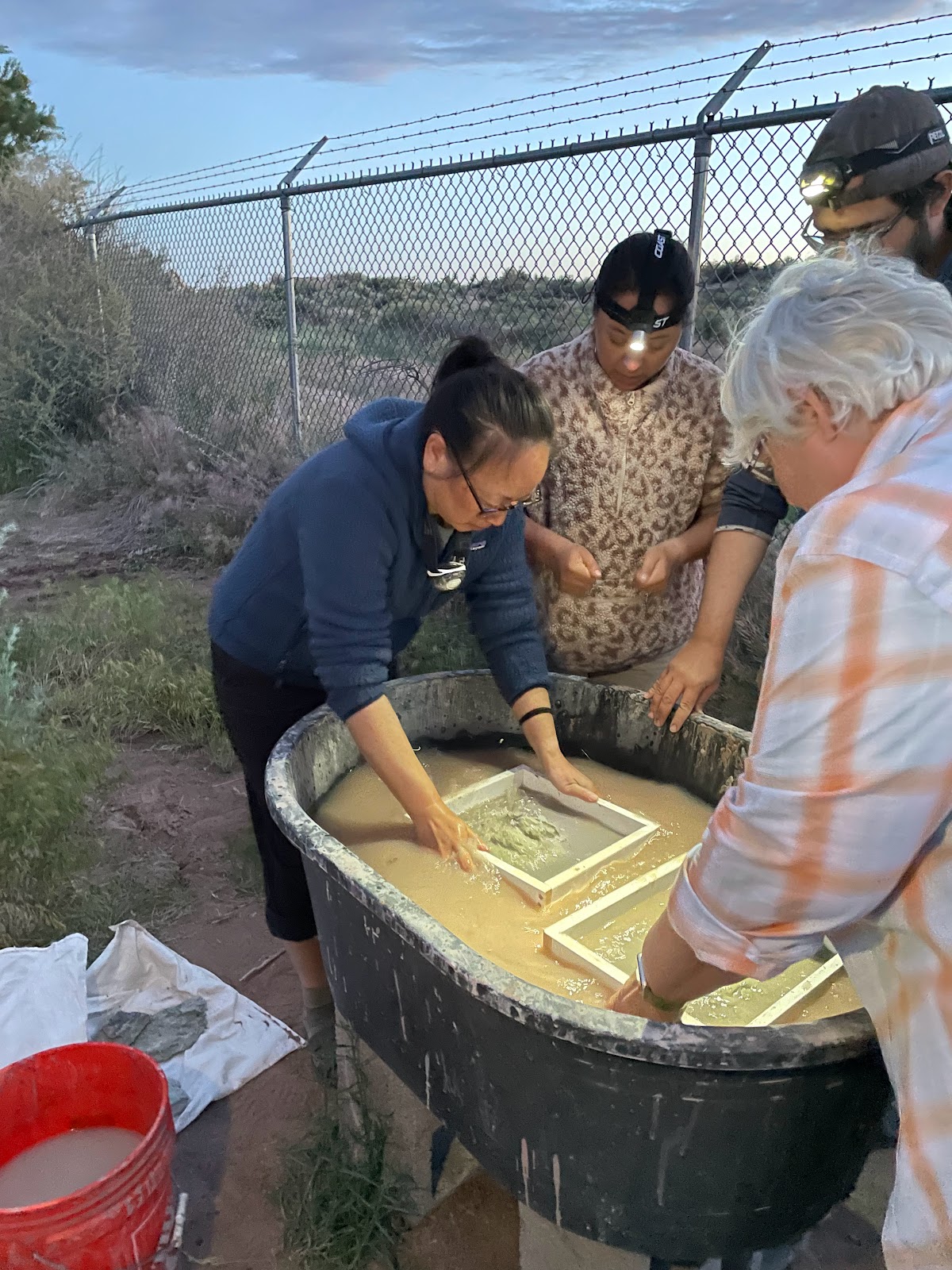A fossil is the preserved trace of any living thing – it’s not just the remains of the organism itself (bones, teeth, etc.), but it could be a trace of what it leaves behind (footprints, imprint, scales, hair, etc.). Fossils are formed when an object is quickly covered by sediment, then - most importantly - it is sealed. The tissue decomposes and is replaced by minerals, which take the shape of the original object. Most things don’t get turned into fossils since it takes just the right conditions - in fact, Sterling believes around 99.9% of things are NOT turned into fossils, and most fossils are delicate and are therefore destroyed through the passage of time. Nonetheless, we found plenty.
 |
| Arriving at the Green Site |
Hunting for fossils is a similar process – if you correctly read the landscape, you can make an educated guess where fossils might be, and it becomes luck after that.
 |
| Michelle, with her find! |
It was also interesting to see the different animals found in the park during the Triassic, including aetosaurs (big, heavily armored reptiles that sometimes grew spiked bony plates), metoposaurs (3 meter long salamander-like amphibians whose heads can be described as 'toilet seats'), and phytosaurs (huge crocodile-like reptiles that grew up to 4 meters long with long pointed snouts and huge sharp teeth at the end). One note - there were very few dinosaurs in the park and our main digs were not looking for dinosaurs.
THE GREEN SITE - DIGGING FOR FOSSILS
We traveled just outside the National Park to private land that Sterling and Michelle had found several years ago. To identify the site, they'd looked at the landscape on Google Earth and, based on color and texture, determined it was a good location; they then contacted the owners and got permission to prospect. They camped and hiked around the badlands until they spotted some fossil teeth on the ground. Sterling says he put his hand in the dirt and pulled out a handful of teeth, so they knew it would be a good fossil site.
The Green Site, where we spent the day, is located in the Jim Camp Beds of the Sonsela Member of the Chinle Formation, formed between 212 and 216 million years ago. The different layers are bluish/purple, and faintly green, located just below the tan Martha’s Butte sandstone. (Martha's Butte beds were easy to distinguish, as it was the only layer that had plants growing in it.) The purple color of the Jim Camp beds tells us there was standing water, and sure enough we found remnants from several aquatic species. We were digging in one of the lighter layers of the Jim Camp beds, where the soil had a bit of a greenish tint - thus the name Green Site.
 |
| It was so frustrating at first as everything seemed to look the same, but very quickly I learned how to spot the fossils - and they truly were everywhere! |
 |
| My haul, that we were allowed to keep: teeth, coprolite, and bone fragments |
Bone fragments are porous and often have a textured section that looks just like modern bone. Because it is porous, it will stick to your tongue, so sometimes paleontologists will lick their find as a test.
 |
| So clear under a microscope! |
In the past at this site, the team had found several phytosaurs – large, semi-aquatic, armored carnivores that resemble modern-day crocodiles (but aren’t related – it’s just parallel evolution), so there was a definite possibility of finding larger fossils. But I spent the day working with post-doc researcher Davide, who was looking for microfossils. To do this, we learned how to split rocks.
We sat in the dirt with a shoe-box sized hunk of rock, then put a flathead screwdriver along one of the natural seams and hammered until the rock split. We then examined the newly exposed surface, looking for anomalies in the light grey surface. Most dark specks were traces of some former organic material – often a tooth, scale, jaw, or poop. It was like opening Christmas presents! Sometimes it was nothing good – like getting socks or underwear. But once in a while… you unwrap an Xbox!
 |
| The drepanosaur claw |
Another side note: the Drepanosaur is a very wacky creature. It’s a… lizard (?). With a hump like a bison, opposable toes, a prehensile tail ending in a scorpion-like spike, and a single giant claw on its front ‘hand’. It's like the maker took all the leftover parts when he was making creatures and lumped them all together!
 |
| The partially-excavated osteoderm |
 |
| An exciting find... but what is it??? |
 |
| The complete osteoderm |
 |
| Prepping the fossil for its cast |
I did for a moment look in on the plaster casting - creating a protective "jacket" around larger fossils so that they can be safely moved from the field (but I returned to splitting rocks and didn't help out). To create the jacket, the top half of the fossil is encased in plaster in situ, then the dirt around it is carefully scraped away and the fossil is brought back to camp. There, the rest of the jacket is plastered on to fully protect the fossil. Since I missed out on the process in the field, I tried my hand at closing up the jacket at camp.
To finish plastering the sample, we first laid down a thick layer of toilet paper over any exposed rock, keeping it in place with a little dab of water. After the entire rock was covered, we mixed plaster (the more you agitate it, the harder the final cast!) and quickly covered the rest of the specimen.
The other process we learned was how to sift for microfossils. Davide showed us how to process the many pounds of rocks we’d brought back so that he wouldn't have to transport it all back to his lab. He soaked the sandstone chunks in water for several hours until it turned into mud. Then, we put the mud through a sieve and swirled it in water, much like panning for gold, to filter out all the unwanted sediment. We had to take care not to agitate the mix too hard for fear of destroying all the delicate pieces. The smaller sand and mud filtered out the bottom of the sieve, leaving behind the larger pieces including all the fossils. These remnants would be left to dry, and then collected and brought back to the lab to be sorted under a microscope. By going through this process, a huge 50-pound bag of rocks could be reduced to the size of a gallon Ziploc bag.
CRYSTAL FOREST – PETRIFIED TREES
The next morning, we went to see one of the park’s namesake Petrified Forests. The Crystal Forest is known for its ‘clunkers’ – trees with a high concentration of quartz crystals. Trace minerals cause different colors in these trees, including reds/oranges/yellows from iron and manganese, and blues/greens from cobalt, copper, and chromium. And apparently there used to be a lot of amethyst (!!) but much of it was taken by past visitors. There are also ‘clinkers’ – petrified trees that make a ‘clinking’ sound when knocked together.
225 million years ago when these trees were alive, Pangaea had yet to break apart and this area of Arizona was much closer to the equator. The environment was much more tropical - hot and humid, with many lakes, rivers, and rainforests. The fallen trees (many were conifers like monkey puzzle trees) were covered by high-energy water, which moved enough sediment to completely bury the logs. A clue that the water was fast-moving are the rounded pebbles, which needed fast water to rub them smooth. After petrification, the landscape must have been uplifted, then eroded to uncover the petrified logs. In some areas, the logs look as though they have been cut cleanly into pieces with a saw – these have been broken from the movement of shifting land; but if there is enough support, the log stays fairly intact. In other areas, the trees have crumbled and look a lot like wood chips.
BLUE MESA – DYING GROUNDS
 |
| Learning about the landscape with Ranger Bill |
 |
| Annie Alexander: how badass is she??? |
Along the way, we stopped at the campsite of Annie Alexander, the UC Berkeley paleontologist who explored the area in the 1920s. Great seeing some female STEM representation!!
Near Annie's campsite, we stopped to examine a section of newly exposed cliff to see if we could 'read the rock'. Sterling showed us signs of bioturbation - areas where something organic disturbed the soil, leaving traces of its presence. These discolored sections could have been from animals that burrowed into the ground causing a mixing of the soil, or roots whose nitrogen nodules discolor the dirt. Sometimes, the disturbance causes two rocks to rub against each other, creating a small patch of shiny surface known as a slickenside.
 |
| Lots of things died in the Dying Grounds - and fossils were abundant! |
Again, it was interesting how quickly I learned to spot a fossil. Initially, I just saw dirt and rocks and was amazed when Sterling kept picking up fossils and handing them to me, saying "Here's a tooth. Here's a metoposaur."
 |
| A nice collection of fossils! |
 |
| Metoposaur interclavicle fragments |
 |
| A huge phytosaur front tooth, in situ |
PAINTED DESERT – PROJECT DAY
The final day of the workshop was a culmination of everything we'd learned - we were split into teams and sent out into the field. We were told that a paleontologist had lost their field notebook, leaving nothing behind but the coordinates of their find. Our task was to locate their find using a GPS, then read the surrounding landscape to tell the story of that fossil.
Sterling led our team (Kiki, Mary Ellen, Molly, and I) up to the northern end of the park and into the Painted Desert. Using a GPS unit, we found the site of an active dig where they had found dinosaur fossils - an early carnivorous therapod called Coelophysis. Based on the clues around us, we had to tell its story - where it lived and what its environment was like.
By carefully examining the rock, we discovered layers of siltstone, sandstone, and mudstone. Mudstone and siltstone are very fine layers of sediment, where the grains that make up the rock are too small to see with the naked eye. To differentiate the two, you can take a small piece and rub it between your teeth - siltstone feels gritty since it is slightly larger; mudstone is smaller and will feel smooth. In sandstone, the grains are larger and can be seen with the naked eye. Based on the grainsize of the sediment, you can determine the energy level of the water that deposited it. Fast flowing water (high energy) will carry away smaller sediments and leave larger pebbles, and slower or standing water (low energy) will deposit finer sediment. Because we were finding mudstone and siltstone, we could determine the layer was deposited perhaps in a lake or pond-like environment. The lake dried and reappeared several times throughout history, as evidenced by the differing color layers that we observed.
 |
| Phytosaur and lungfish teeth, along with other bone fragments found at the site |
We learned how to draw a stratigraphic diagram, showing the differing layers of rock and the items we found in each layer. From our notes, we needed to come up with the story of our missing paleontologist's find and present it to the rest of the group.
It was nerve-racking presenting our story since I was still not very confident about my rock-reading abilities, but my team pulled through!
Overall, the DIG workshop was an amazing and eye-opening experience. I learned so much, not just about paleontology, but about geology and the ancient history of the area. It gave me a profound appreciation for the deep history of the earth - about how old it is and how many stories are hidden in the layers of rock. I'll never look at dirt the same way again!



















